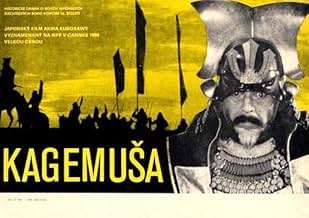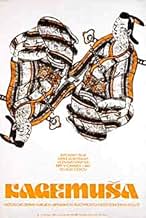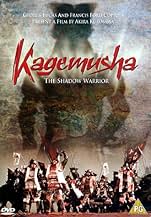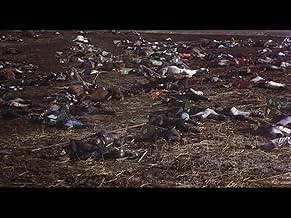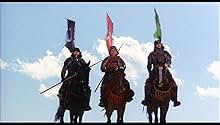NOTE IMDb
7,9/10
40 k
MA NOTE
Un larron ressemblant comme deux gouttes d'eau à un grand seigneur est épargné pour jouer la doublure du samouraï. À la mort de ce dernier, il est contraint de prendre les armes à sa place.Un larron ressemblant comme deux gouttes d'eau à un grand seigneur est épargné pour jouer la doublure du samouraï. À la mort de ce dernier, il est contraint de prendre les armes à sa place.Un larron ressemblant comme deux gouttes d'eau à un grand seigneur est épargné pour jouer la doublure du samouraï. À la mort de ce dernier, il est contraint de prendre les armes à sa place.
- Réalisation
- Scénario
- Casting principal
- Nommé pour 2 Oscars
- 20 victoires et 5 nominations au total
Avis à la une
What happens to the doppelganger when the original dies? Does he flitter out of existence or does he find his own. Kagemusha (shadow warrior in Japanese) is the story of a thief who is to be hanged, but is saved by a warlord's brother, Katsuyori Takeda, because of a peculiar resemblance to the king Shingen Takeda. Tatsuya Nakadai brilliantly plays both roles of Shingen and the thief. The thief is trained to fill in as Shingen's double, a position previously played by his brother Katsuyori. Shingen receives a mortal wound during a siege and the Takeda Clan retreat. His dying wish is that he wants his death not to be known for at least three years. Kagemusha eventually acquiesces to the role of not just doubling for the king, but being a figurehead twenty-four hours a day.
The intimate circle of Shingen's family and guard knows about the double. They advise him about how to be like Shingen. He plays the part well. Shingen's son Nobukado, who knows that he is the double, is convinced that his father did this to spite him. Nobukado was passed over as king and that position was granted to Shingen's grandson and Nobukado's son Takemaru as soon as he reaches of mature age. Later in the film, we realize that Shingen did this because Nobukado is too aggressive and is not leader material, not to spite him. The backing of Kagemusha helped Nobukado's one great military victory. Nobukado would forever be in Shingen's shadow.
The relationships between the thief and the Lord's men make this a fascinating film. There is a rich tapestry of multidimensional characters. To some critics the action was too slow. It was not as fast paced as The Seven Samurai or Yojimbo. I think it is a mature film from a maturing director who would go on to direct another of my favorite films Ran. This film was nominated for two academy awards and would co-win the grand prize at the Cannes Film Festival. The juxtaposition between the titanic and minute is a favorite concept of Kurosawa. Stolid men have tragic faults. Beggars can be kings.
Kurosawa is one of the world's most famous directors. Yet in the 1980's, he did not get much respect from his home country Japan. He had not had released a film since 1975 -- the beautiful and brilliant Dersu Uzala and he was reportedly suicidal. This film would not have been made if it were not for George Lucas and Francis Ford Coppola whom helped finance this film. Lucas has always been a big fan of Kurosawa. Star Wars was partially influenced by Kurosawa's film The Hidden Fortress. I am a big fan of Kurosawa too. His films always have the most beautiful cinematography, intricate plots and grand characters. Kagemusha is no exception.
The intimate circle of Shingen's family and guard knows about the double. They advise him about how to be like Shingen. He plays the part well. Shingen's son Nobukado, who knows that he is the double, is convinced that his father did this to spite him. Nobukado was passed over as king and that position was granted to Shingen's grandson and Nobukado's son Takemaru as soon as he reaches of mature age. Later in the film, we realize that Shingen did this because Nobukado is too aggressive and is not leader material, not to spite him. The backing of Kagemusha helped Nobukado's one great military victory. Nobukado would forever be in Shingen's shadow.
The relationships between the thief and the Lord's men make this a fascinating film. There is a rich tapestry of multidimensional characters. To some critics the action was too slow. It was not as fast paced as The Seven Samurai or Yojimbo. I think it is a mature film from a maturing director who would go on to direct another of my favorite films Ran. This film was nominated for two academy awards and would co-win the grand prize at the Cannes Film Festival. The juxtaposition between the titanic and minute is a favorite concept of Kurosawa. Stolid men have tragic faults. Beggars can be kings.
Kurosawa is one of the world's most famous directors. Yet in the 1980's, he did not get much respect from his home country Japan. He had not had released a film since 1975 -- the beautiful and brilliant Dersu Uzala and he was reportedly suicidal. This film would not have been made if it were not for George Lucas and Francis Ford Coppola whom helped finance this film. Lucas has always been a big fan of Kurosawa. Star Wars was partially influenced by Kurosawa's film The Hidden Fortress. I am a big fan of Kurosawa too. His films always have the most beautiful cinematography, intricate plots and grand characters. Kagemusha is no exception.
Akira Kurosawa is certainly one of the most important directors who ever lived. Most of his most famous films were made in the 50s and 60s. Rashomon, Ikiru, Yojimbo, and The Seven Samurai may be the four most famous films he made, and they were all in black and white. That format was wonderful. His films had a definitive look in that era.
I would like to suggest, though, that he was the single best director of the color image who has existed thus far (whose work I am familiar with). I have only seen two of his color films (I don't even know how many he made), this film and Ran, but his sense of color in these two films is exquisite. I had to pause it several times during Kagemusha just to stare at the beautiful composition.
I personally think that Kurosawa's talents rested mainly in the technical aspects of his films rather than the content (and I'm sure many people would argue against me here). So as for the film itself, I'd give it a 9/10 for two reasons. I was only emotionally involved during small sections of the film (the end was particularly powerful), and the story was somewhat difficult to follow (I was confused during Yojimbo and The Seven Samurai, too). I prefer Ran to this film (and to all the other films of his I've seen, which include Rashomon, The Seven Samurai, and Yojimbo). Still, Kagemusha is very good.
I would like to suggest, though, that he was the single best director of the color image who has existed thus far (whose work I am familiar with). I have only seen two of his color films (I don't even know how many he made), this film and Ran, but his sense of color in these two films is exquisite. I had to pause it several times during Kagemusha just to stare at the beautiful composition.
I personally think that Kurosawa's talents rested mainly in the technical aspects of his films rather than the content (and I'm sure many people would argue against me here). So as for the film itself, I'd give it a 9/10 for two reasons. I was only emotionally involved during small sections of the film (the end was particularly powerful), and the story was somewhat difficult to follow (I was confused during Yojimbo and The Seven Samurai, too). I prefer Ran to this film (and to all the other films of his I've seen, which include Rashomon, The Seven Samurai, and Yojimbo). Still, Kagemusha is very good.
10george-b
I am a fan of Kurosawa and have seen many of his films many times. There is a sweep and an ache to Kagemusha that is genuine and has remained in my heart's memory. Unlike Ran, it is not Shakespearean. Unlike Seven Samurai, my favorite all-time film and I believe the best film ever made, it is not a western.
Although epic, it is about a sweet and rueful soul swallowed by karma and history. It is redemptive without overt sentiment, and the lead performance by Tatsuya Nakadai is nuanced and unforgettable.
I will always remember this film, not for its complexity or savagery, but for the simplest moments between Lord and subject, between the highest self and the lowest self, and most particularly, the very real pain of a man caught in the vise of his own life and death.
Although epic, it is about a sweet and rueful soul swallowed by karma and history. It is redemptive without overt sentiment, and the lead performance by Tatsuya Nakadai is nuanced and unforgettable.
I will always remember this film, not for its complexity or savagery, but for the simplest moments between Lord and subject, between the highest self and the lowest self, and most particularly, the very real pain of a man caught in the vise of his own life and death.
8ccwf
This film is set at the beginning of the Warring States era of Japanese history, which most Japanese film viewers would have studied extensively in school. Unfortunately for Western viewers, these historical aspects are therefore given little exposition, making some aspects of the film hard to follow for those without such schooling.
Here are some attempts at "liner notes" to help in understanding and appreciating the film (warning: I'm not Japanese and have not had Japanese schooling):
* Shingen Takeda is a warlord vying for power with Oda Nobunaga and his ally Ieyasu.
* Takeda had a reputation for the military prowess of their cavalry. Thus, you see lots and lots of horses featured in the film. Horses were important to the clan. Takeda's symbol is the four diamonds (the exact symbolism is explained in the film). Just as in the West, use of such heraldic symbols in war banners and clothing was very useful in figuring out who is who. So, keep in mind that when you see the four diamonds, whatever their color, those are Takeda forces.
* Nobunaga was known for his adoption of many Western ways. This is why he wears European-influenced clothing and doesn't have the standard samurai haircut (basically, shaved head, topknot). Nobunaga was also known for his use of rifles in battles. So, one of the themes of the film is the struggle of tradition against the influence of the West (in the film, mostly shown through the use of guns although their is also a brief shot of some clerics). Nobunaga's symbol is the five-sectioned flower. Nobunaga is also known for his love of Noh dramas, a dramatic form incorporating difficult-to-understand archaic language and restrained, careful action, somewhat like the film "Kagemusha" itself. Nobunaga launches into a bit of Noh at one point in the film.
* At this early time, Ieyasu was mostly known for his political survival skills. Ieyasu is probably best known to American viewers as the basis for James Clavell's Toranaga character in "Shogun". (Nobunaga is also in "Shogun" albeit as a minor character and under a different name.) The events in this film take place roughly two decades prior to those in "Shogun".
* Takeda's generals each also have their own symbols to help you track them. One of Ieyasu's generals also has a "symbol" (actually, the character "hon", which IMDb will not display).
* Haircuts are a sign of rank. This is why all the lords (except Nobunaga) have a certain haircut, all the pages have the same hairstyle, and so forth. The haircut~rank connection figures even more strongly and explicitly in Kurosawa's "Throne of Blood".
* Japanese men during this period often changed their names as their status changed. For example, in "Toshie to Matsu", Toshie, who is one of Nobunaga's (and, later, Hideyoshi's and Ieyasu's) generals/lords is granted the honor of changing his name to one which incorporates part of his lord's name into his own. Keep this in mind as Takeda's son discusses the use of his father's name and symbol.
* Miltary success and bravery in battle were key means of advancement. Thus, military leaders of this time are often depicted as ever-volunteering to do brave (even stupidly brave) things in hopes of gaining greater status. In "Kagemusha", Takeda's son is desperate for such advancement.
Here are some attempts at "liner notes" to help in understanding and appreciating the film (warning: I'm not Japanese and have not had Japanese schooling):
* Shingen Takeda is a warlord vying for power with Oda Nobunaga and his ally Ieyasu.
* Takeda had a reputation for the military prowess of their cavalry. Thus, you see lots and lots of horses featured in the film. Horses were important to the clan. Takeda's symbol is the four diamonds (the exact symbolism is explained in the film). Just as in the West, use of such heraldic symbols in war banners and clothing was very useful in figuring out who is who. So, keep in mind that when you see the four diamonds, whatever their color, those are Takeda forces.
* Nobunaga was known for his adoption of many Western ways. This is why he wears European-influenced clothing and doesn't have the standard samurai haircut (basically, shaved head, topknot). Nobunaga was also known for his use of rifles in battles. So, one of the themes of the film is the struggle of tradition against the influence of the West (in the film, mostly shown through the use of guns although their is also a brief shot of some clerics). Nobunaga's symbol is the five-sectioned flower. Nobunaga is also known for his love of Noh dramas, a dramatic form incorporating difficult-to-understand archaic language and restrained, careful action, somewhat like the film "Kagemusha" itself. Nobunaga launches into a bit of Noh at one point in the film.
* At this early time, Ieyasu was mostly known for his political survival skills. Ieyasu is probably best known to American viewers as the basis for James Clavell's Toranaga character in "Shogun". (Nobunaga is also in "Shogun" albeit as a minor character and under a different name.) The events in this film take place roughly two decades prior to those in "Shogun".
* Takeda's generals each also have their own symbols to help you track them. One of Ieyasu's generals also has a "symbol" (actually, the character "hon", which IMDb will not display).
* Haircuts are a sign of rank. This is why all the lords (except Nobunaga) have a certain haircut, all the pages have the same hairstyle, and so forth. The haircut~rank connection figures even more strongly and explicitly in Kurosawa's "Throne of Blood".
* Japanese men during this period often changed their names as their status changed. For example, in "Toshie to Matsu", Toshie, who is one of Nobunaga's (and, later, Hideyoshi's and Ieyasu's) generals/lords is granted the honor of changing his name to one which incorporates part of his lord's name into his own. Keep this in mind as Takeda's son discusses the use of his father's name and symbol.
* Miltary success and bravery in battle were key means of advancement. Thus, military leaders of this time are often depicted as ever-volunteering to do brave (even stupidly brave) things in hopes of gaining greater status. In "Kagemusha", Takeda's son is desperate for such advancement.
10Hitchcoc
This is a great epic of war and a film of great emotion. At the center is a man who has nothing. He is thrust into a world he didn't create. He is a petty thief and really would like to just get on with his life. What he also has is great loyalty to his now deceased lord, and despite his great concern for his ability to carry it off, he agrees to the position. He has to know that at some point this will all come crashing down. The Samurai code makes it so that he has few options. He runs the war the best he can but occasionally falls victim to who he is. Even with advisers watching his every move, he becomes so much a part of the entire picture that he is left to destroy himself, and, in the process, the clan that he represents. The battle scenes are remindful of the other huge films like "Ran" and "Throne of Blood." They sweep across the screen with the flag carrying horsemen and the infantry fighting until there is nothing left but total carnage. Because of the complexity of the story and the wonderful acting, I would put this at or near the top of my Kurosawa list.
Le saviez-vous
- AnecdotesMuch of the film recounts actual historical events, including Shingen's death and the two-year secret, and the climactic Battle of Nagashino in 1575. Those scenes are also modeled closely on detailed accounts of the battle.
- GaffesIn the final battle there are at least 100 riflemen shown firing their matchlock rifles in volleys. The smoke generated by the matchlocks almost immediately dissipates. This indicates a more modern gunpowder was used in the matchlocks as the historically correct black powder load would blanket the battlefield with thick smoke after a handful of volleys.
- Citations
Nobukado Takeda: The shadow of a man can never stand up and walk on its own.
- Versions alternativesIn the original Japanese version, there are 20 minutes featuring Kenshin Uesugi. For some reason, these scenes were cut out of the USA version.
- ConnexionsFeatured in A.K. (1985)
Meilleurs choix
Connectez-vous pour évaluer et suivre la liste de favoris afin de recevoir des recommandations personnalisées
Détails
- Date de sortie
- Pays d’origine
- Langue
- Aussi connu sous le nom de
- Kagemusha - Director's Cut
- Lieux de tournage
- Himeji Castle, Himeji, Japon(Nobunaga's castle)
- Sociétés de production
- Voir plus de crédits d'entreprise sur IMDbPro
Box-office
- Budget
- 6 000 000 $US (estimé)
- Montant brut aux États-Unis et au Canada
- 4 000 000 $US
- Montant brut mondial
- 4 018 532 $US
- Durée3 heures
- Couleur
- Mixage
- 4-Track Stereo(original version)
- Rapport de forme
- 1.85 : 1
Contribuer à cette page
Suggérer une modification ou ajouter du contenu manquant

Lacune principale
By what name was Kagemusha, l'ombre du guerrier (1980) officially released in Canada in French?
Répondre

